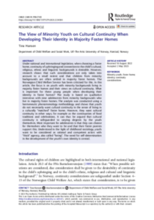Abstract:
Under national and international legislation, when choosing a foster home, continuity of upbringing and connection to the child’s cultural, religious, ethnic and linguistic backgrounds is desirable. However, research shows that such considerations are only taken into account to a small extent and that children from minority backgrounds are often settled in majority foster homes. The Norwegian Child Welfare Service has been criticised for this.
In this article, the focus is on youth with minority backgrounds living in majority foster homes and their views on cultural continuity. What is important for these young people when developing their identity in foster homes? The study is based on qualitative interviews with nine adolescents from minority backgrounds who live in majority foster homes. The analysis was conducted using a hermeneutic phenomenology methodology and shows that youth do not necessarily want cultural continuity in the sense of living in a culturally “matched” foster home.
However, they want cultural continuity in other ways, for example as the continuation of food traditions and celebrations. It can thus be argued that cultural continuity is safeguarded to varying degrees by the youth themselves. Most important for adolescents is that they can choose for themselves who they want to be and that their foster parents support this. Understood in the light of childhood sociology, youth want to be considered as rational and competent actors with “thick” agency, also called “being”. The need for self-determination in the development of the youth’s own identity is central.

